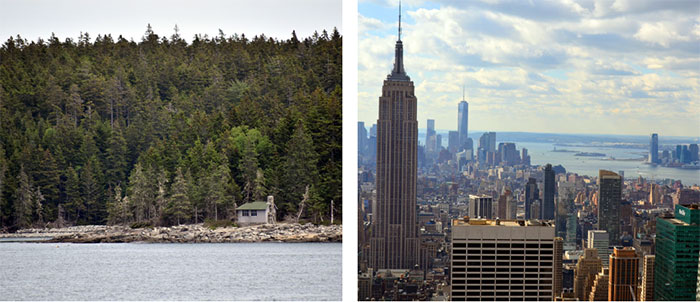Human Impacts: How Can Our Impact Be Assessed?
A Carolina Essentials™ Activity

Total Time: 45-75 mins
Prep: 15 mins | Activity: 30-60 mins

Life Science
- Total Time: 45-75 minutes [ Prep: 15 mins | Activity: 30 mins ]
- Subject: Life Science
- Grade: High School
Overview
There is no doubt that human activities impact the environment. Man-made structures can be seen from space. Night lights imagery from NASA shows locations of people and the infrastructure to support them. Water quality data go back decades and weather data even further.
When you look at the impact humans have on the environment, a number of factors come into play. Data must be available so claims about the impact of human activity can be evaluated and an argument made for continuing, decreasing, modifying, or stopping the activity. Here are a few things to think about:
- Are the impacts minor or major?
- What and who are affected by the impact?
- Can the impact be reversed or mitigated?
- Is the impact short-term or long-term?
- How can data be collected to assess the impact of the human activity?
- What data needs to be collected, and for how long?
In this introductory activity, students look at pictures of similar activities to decide what the impacts are to the environment, what data should be collected, and how to collect it. This is a straightforward task at first glance, but it gets convoluted as students begin to ask more detailed questions about impacts and the data necessary to support a claim. A discussion of the phenomenon below sets the parameters for how much detail you want students to include.
Phenomenon
Show students the picture below of the US Gulf Coast at night. The southeast Texas coast is on the left side of the picture; Houston is the largest lighted area. The Mississippi Delta, and New Orleans, is to the right. Students may pick out light from oil rigs in the Gulf. Note that the atmosphere boundary is visible at the top of the picture.
Ask students what they see and to think about human impact on a global scale. What do they need to know to determine how human activities impact the planet? Discuss their thoughts as a class or in a small group setting before beginning the activity. This is a good place to frame your expectations for the scope of questions asked and types of data collected as students analyze the pictures of human activities.

Essential Question
What information is necessary to design a solution that reduces the impacts of human activities?
Activity Objectives
- Through group consensus, design a form that can be used to rate the impact of human activities prior to designing a solution that reduces the impact. Use the claim, evidence, reasoning (CER) framework .
Next Generation Science Standards* (NGSS)
HS-LS2-7. Design, evaluate, and refine a solution for reducing the impacts of human activities on the environment and biodiversity.
HS-ESS3-4. Evaluate or refine a technological solution that reduces impacts of human activities on natural systems.
Science & Engineering Practices
Constructing Explanations and Designing Solutions
- Design or refine a solution to a complex real-world problem based on scientific knowledge, student-generated sources of evidence, prioritized criteria, and tradeoff considerations.
Disciplinary Core Ideas
LS2.C: Ecosystem Dynamics, Functioning, and Resilience
- Moreover, anthropogenic changes in the environment-including habitat destruction, pollution, introduction of invasive species, overexploitation, and climate change-can disrupt an ecosystem and threaten the survival of some species.
ESS3.C: Human Impacts on Earth Systems
- Scientists and engineers can make major contributions by developing technologies that produce less pollution and waste and that preclude ecosystem degradation.
ETS1.B: Developing Possible Solutions
- When evaluating solutions, it is important to take into account a range of constraints, including cost, safety, reliability, and aesthetics, and to consider social, cultural, and environmental impacts.
Crosscutting Concepts
Stability and Change
- Feedback (negative or positive) can stabilize or destabilize a system.
Materials
- Copies of student pages or online access
Safety Procedures and Precautions
No PPE is required for the activity.
Teacher Preparation and Disposal
Copy the student pages or upload to a class webpage.
Student Procedures
- Individually, look at the pairs of pictures below. Think carefully, short term and long term. In the space provided, jot down what information you need to know about the impacts of each human activity. Include what evidence you would need to gather to assess the impacts of each activity.
- Share the information above that is critical for assessing impacts of human activities with your group members. Come to a consensus about the data that must be collected and questions that must be answered to make claims that rate the impacts of human activities.
- Design a general form to rate the impacts of human activities. Be prepared to defend the form.
Teacher Preparation and Tips
- Discuss with students the expectations for the extent of questions and data collection
- Decide on a time limit for step 1.
- Decide on a time limit for step 2.
- After students in a group come to consensus for what is to be included have them begin constructing a form. You may want to have them include a rating scale for sections and then an over-all recommendation.
- Have each group share their results. As a class, you may want a final form to use with different topics and activities.
Data and Observations
Representation of possible student questions, ideas, and inferences. Remind students that these questions and ideas are meant to drive decisions on what data needs to be collected before designing a solution to a problem.
Human Activities

Student Response
Large scale monoculture, probably a heavy reliance on fertilizers and pesticides, highly regulated, must have runoff mitigation.
Small family garden. No regulations on type and quantity of fertilizers, amount of water, soil erosion
Questions-what’s being done to protect the land, local ecosystem, water quality. Does the amount of food produced justify the land use? What was cleared/disturbed to make the fields? How much “energy” goes into producing the crop?

Student Response
How are goods and services delivered? How much land does it take per person to live under both conditions? How is waste dealt with? What impact is there on the water quality? What is the cost to the environment for transportation, electricity, heat, food, etc.?

Student Response
What’s the long term and short-term environmental damage to produce energy to cook food? How is the energy transported? What if the open flame starts a forest fire?

Student Response
The sky in both pictures looks hazy. What’s causing the haze over the mountains? Does air pollution travel? Is the haze a natural phenomenon? What is sunlight doing to the exhaust? Is the air healthy to breathe?
Analysis & Discussion
Student answers will vary based on individual contributions. At this point, you may want to have all the groups share their consensus results, then have a whole class discussion and decide, as a class, what the critical criteria are when designing a solution addressing the impacts of human activities. What should be included on the final Human Impacts Assessment form?
Discuss whether the form should use qualitative data, quantitative data, or both. Will the form look like a Likert Scale? How will data be represented: numerical values, percent, graphical, tabular, pictorial?
At this point, decide if you would like one Human Impacts Assessment form, one per group, or individual forms. As topics with human impacts arise, use the student generated form to assess the impacts of human activities. They may find the form needs revising to account for variables that weren’t discussed earlier. The generation and revision process engages students in a number of science and engineering practices, obviously applicable to all science disciplines and to disciplines in the social sciences.
Shop the Kit
Reference Kit
Helpful Links
*Next Generation Science Standards® is a registered trademark of Achieve. Neither Achieve nor the lead states and partners that developed the Next Generation Science Standards were involved in the production of, and do not endorse, these products.
Subscribe to Newsletter
Sign up for free resources delivered to your inbox!
CONTACT US
- 800.334.5551
- product@carolina.com
-
2700 York Rd, Burlington,
NC 27215-3398


